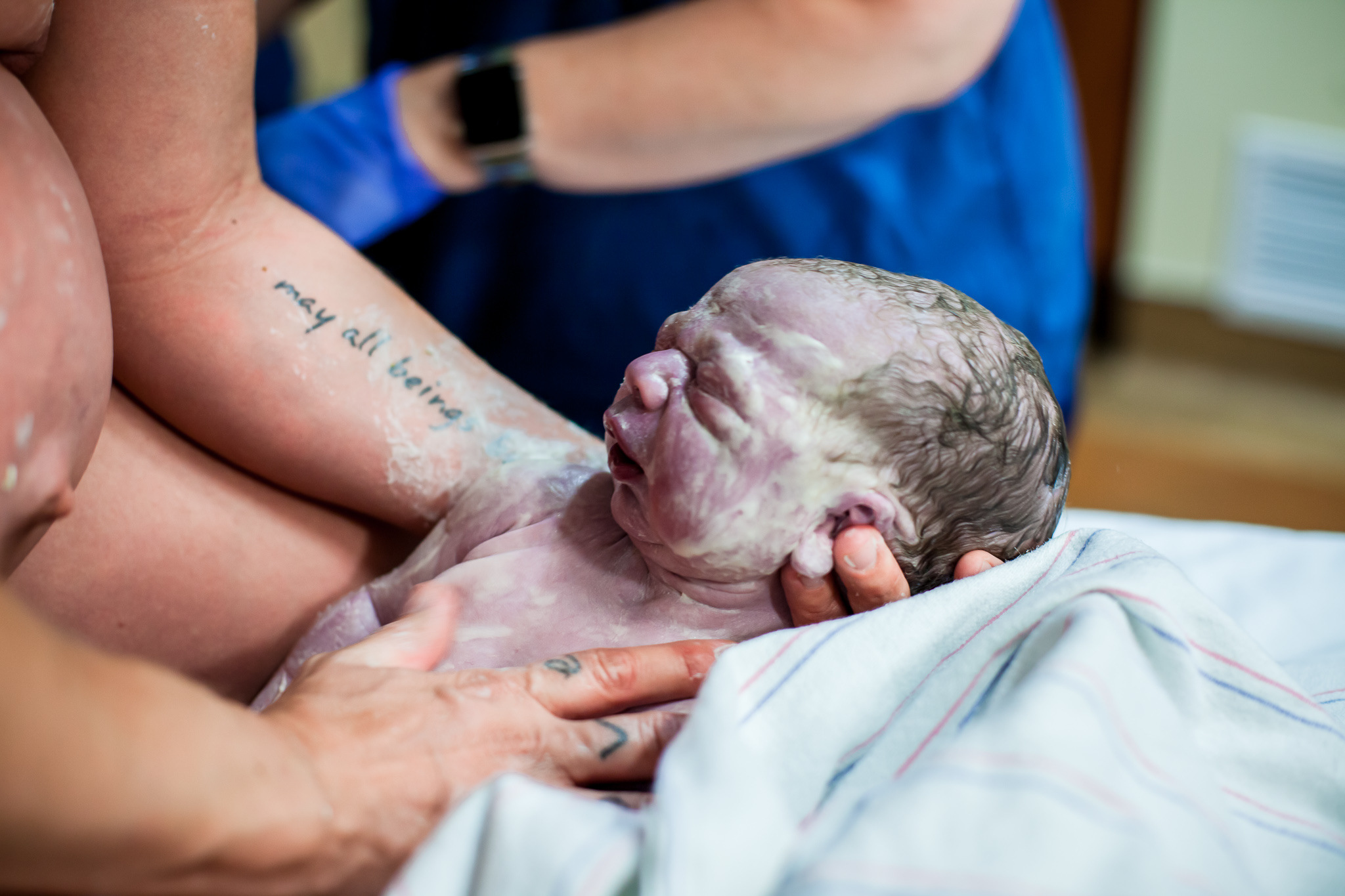Routine Vaginal Examinations in Labour—A useful tool for assessing labour progress?
by Rebecca Wright
It is a commonly held belief that routine vaginal examinations are standard, necessary care for women in birth. Popular pregnancy and birth guides, hospital protocols, and the common practice (of many midwives, doctors, and nurses alike) align in their acceptance of routine internal examinations of labouring women as an essential part of competent care. On-line articles like Mother & Baby’s “Internal Examinations During Labour: How Many Are Necessary?” explain that routine vaginal examinations “will help your labour to progress safely and smoothly” (Mother & Baby). In hospital and at home, care providers use routine vaginal examinations to determine labour progress. Yet routine vaginal examinations in labour are not backed by science—and they carry specific risks to mother and baby. Nonetheless, they remain embedded in common practice in ways that perpetuate uneven power dynamics in the birth room.
Routine vaginal examinations in labour are often treated as the ‘gold standard’ for determining labour progress (Shepard and Cheyne, The Frequency and Reasons for Vaginal Examinations in Labour, 54). The main reasons for routine vaginal examinations in labour are “to diagnose labour onset” and to “assess progress” (Shepard and Cheyne, 51). Common protocol includes one vaginal examination on admission to care followed by 4-hourly assessments in a normal labour (Shepard and Cheyne, 50). Internal examinations at regular timed intervals to plot labour progress does make sense according to the logic of medico-technical birth. In this model, these examinations provide an ostensibly objective and reliable measure that labour is functioning well—and presumably a fair indication of the genuine need for intervention in a dysfunctional labour. Here the woman’s body becomes a machine that must behave in reliable and predictable ways—its job is simply to open the cervix and release the baby, its progress towards this end charted on the partogram to confirm it’s functionality (Midwife Thinking).
But are routine vaginal examinations in labour really an objective and reliable tool for assessing progress? Perhaps surprisingly, the answer is no. Far from objective and reliable, the subjectivity and imprecision of vaginal examination measurements is confirmed by a number of studies (Royal College of Midwives, Assessing Progress in Labour, 3). In one study of 508 women, where the researcher examined women immediately after a clinician, their assessments agreed in less than half the cases (Buchmann EJ, et al.). Further study has shown that contrary to the mechanistic ideal of a steady curve, cervical opening in natural labour is unpredictable and non-linear (Ferrazzi et al., 2015). Given the subjectivity of measurement and the unpredictability of cervical dilatation, vaginal examinations can offer, at best, only a “snapshot in time” (Midwife Thinking). The RCM state clearly that there are no research-backed recommendations on the timing and frequency of VEs in labour (RCM, 5).
Worse yet, routine vaginal examinations in labour are not a benign procedure for women or their babies. If, as we have seen above, the medico-technical model that validates (by common practice) routine vaginal examinations in labour is deceptive and simplistic, likewise the unspoken assumption it carries of inherent safety and neutrality is optimistic. In fact, routine vaginal examinations in labour carry well-documented and potentially significant risks to mothers and babies, including accidental rupture of the amniotic sac (Midwife Thinking), and an increased risk of infection (RCM, 4). Moreover, many women find vaginal examinations invasive and painful. (RCM 4). While it may be easy for some to dismiss this pain as merely an ‘experience’ issue (i.e., temporary and therefore irrelevant and unimportant), in reality, it can become a critical health issue as for some women the experience of routine vaginal examinations in labour can be a lasting source of PTSD (RCM, 4).
The disturbing power dynamics of routine vaginal examinations in labour come clear when we begin to look at the experiences of real women. Popular articles preparing women for birth encourage compliance: “That moment when the midwife snaps on her gloves and lubes up makes the best of us shudder. But internal examinations are over quickly and will help your labour progress safely and smoothly” (Mother&Baby). Women are guided to look outside themselves both for confirmation that they are indeed in labour and that they are making adequate progress — an approach that enforces the “external expert” taking the woman away from the sense of her own power and trust in her body’s knowing (Midwife Thinking).
While protocols may say “every four hours”, the reality is that VEs may be given more often and without indication (Shepard and Cheyne, 51). One example from AIMS brings together so many of the ideas in this paper (the more frequent than 4-hourly examination, the subjectivity of measurement that leaves the woman with contradictory messages, the enforcement of the ‘external expert’, the unpredictability of labour patterns, trauma caused by VEs in labour) in the personal experience of a first time mother who calls the helpline after her birth:
She went into hospital in strong labour and a lovely, young midwife supported her, did a VE and said she was 7cms dilated. The midwife told her how well she was doing and everyone was delighted. She then told the woman that because she was newly qualified she would need to get a senior midwife to check the VE.
The senior midwife checked and said that she was only 4cms if that. The woman said she ‘crumbled’ and started to cry. She was then offered pethidine which she took because she felt so deflated, and shortly after the baby was born. She described the labour as traumatic. (Derrick, VEs – Essential Diagnostic Tool?)
This woman is not alone in experiencing what could have been an uneventful labour and straightforward birth as “traumatic” because of routine vaginal exams. In other cases, “improper or rough behaviour” by practitioners adds to the trauma in complaints (RCM, p. 4).
The all too common practice of routine vaginal examinations in labour is not backed by current evidence. Instead, it forms part of the backdrop of institutionalised birth, placing a woman in a pre-determined role of subordination to the doctor’s (or other medical care provider’s) expertise and power over her. In the clinical setting, the emotional and psychosexual dynamics of routine vaginal examinations may be ignored, but these have lasting consequences for women after birth. Women’s bodies are not the simple machines the medico-technical model reduces them to. The physiology of labour and birth is delicate and complex, far more so than the mechanistic measure of routine vaginal examinations allows for. Yet these exams are still common practice in birth settings across the board—in hospitals, at birth centres, and at home—even as evidence shows routine vaginal examinations in labour cannot provide the objective reassurance they purport to. Indeed, in many cases, they may cause harm to the very women and babies they are intended to safeguard. Routine vaginal examinations may make sense according to the logic of the medico-technical birth, but this widely-adopted model is not an inevitable (or even accurate) representation of what birth is and how labouring women’s bodies function. Where scientific evidence and routine clinical practice fail to align, to the detriment of women and babies, we need to question why and what we can do better.
Sources:
Buchmann EJ1, Libhaber E. Accuracy of cervical assessment in the active phase of labour. BJOG. 2007 Jul;114(7):833-7.
Dahlen, Hannah; Downe, Soo; Duff, Margie; Gyte, Gill. Vaginal Examination During Normal Labor: Routine Examination or Routine Intervention? International Journal of Childbirth, Volume 3, Number 3, 2013, pp. 142-152(11).
Derrick, Debbie Chippington. VEs – Essential Diagnostic Tool? AIMS Journal, 2010, Vol 22 No 2.
Downe, S, Gyte GML, Dahlen HG, Signet M. Routine vaginal examinations for assessing progress of labour to improve outcomes for women and babies at term. Cochrane Database of Systematic Reviews 2013, Issue 7. Art. No.: CD010088.
Ferrazzi E, Milani S, Cirillo F, Livio S, Piola C, Brusati V, Paganelli A. Progression of cervical dilatation in normal human labor is unpredictable. Acta Obstet Gynecol Scand. 2015 Oct;94(10):1136-44. doi: 10.1111/aogs.12719. Epub 2015 Sep 3.
Midwife Thinking. Vaginal examinations: a symptom of a cervical-centric birth culture. 2 May 2015. Rachel Reed. https://midwifethinking.com/2015/05/02/vaginal-examinations-a-symptom-of-a-cervix-centric-birth-culture/
Mother & Baby. Internal Examinations During Labour: How Many Are Necessary? Alison Coldridge. http://www.motherandbaby.co.uk/pregnancy-and-birth/birth/labour-and-birth/internal-examinations-during-labour-how-many-are-necessary
Mumsnet. Your Legal Rights in Pregnancy and Childbirth. Birthrights. https://www.mumsnet.com/pregnancy/legal-rights-during-pregnancy-and-childbirth.
Royal College of Midwives, “Assessing Progress in Labour.” Evidenced Based Guidelines for Midwifery-Led Care in Labour, 2012.





+ show Comments
- Hide Comments
add a comment